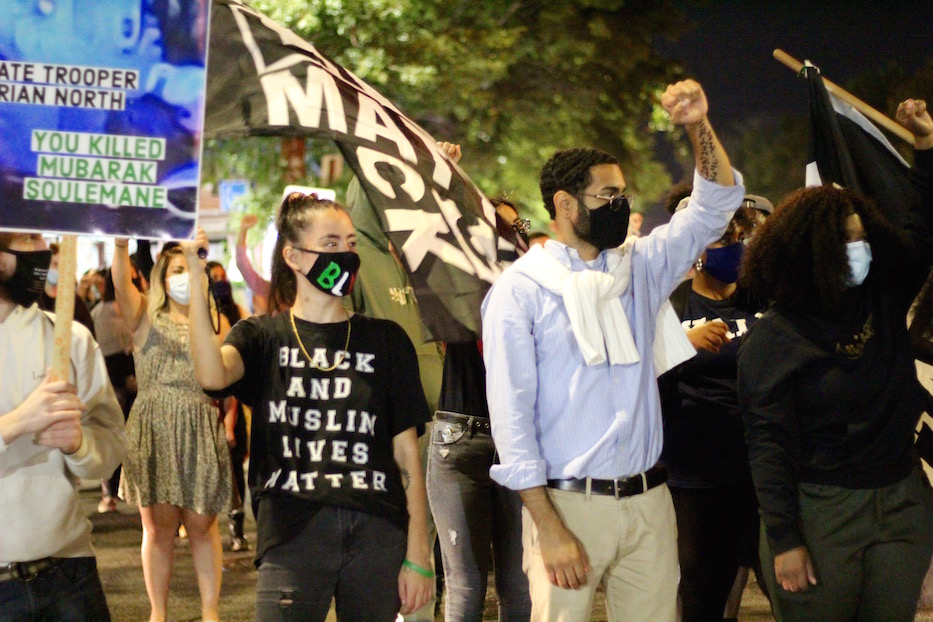
Music | Arts & Culture | Black Lives Matter | COVID-19
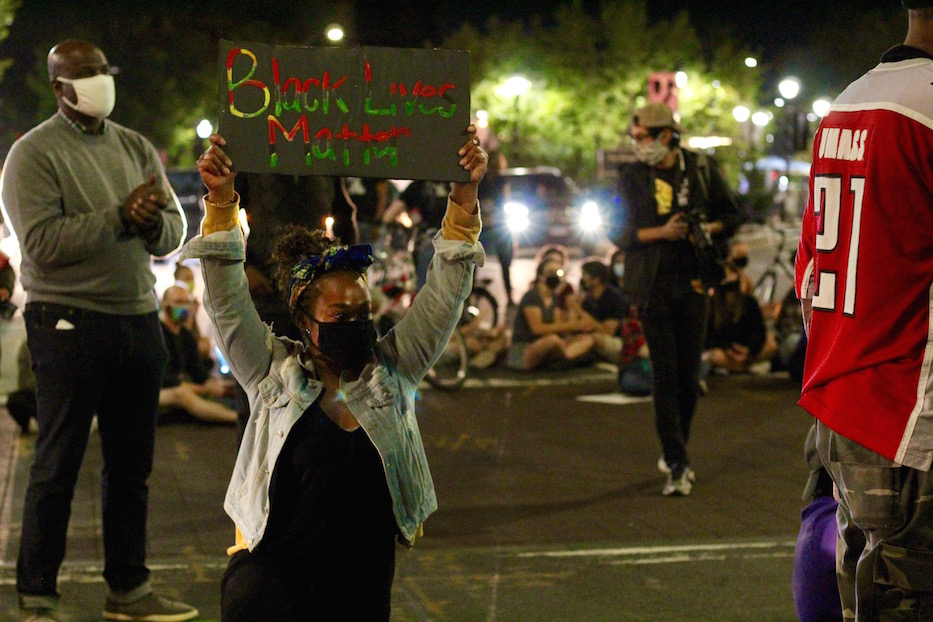
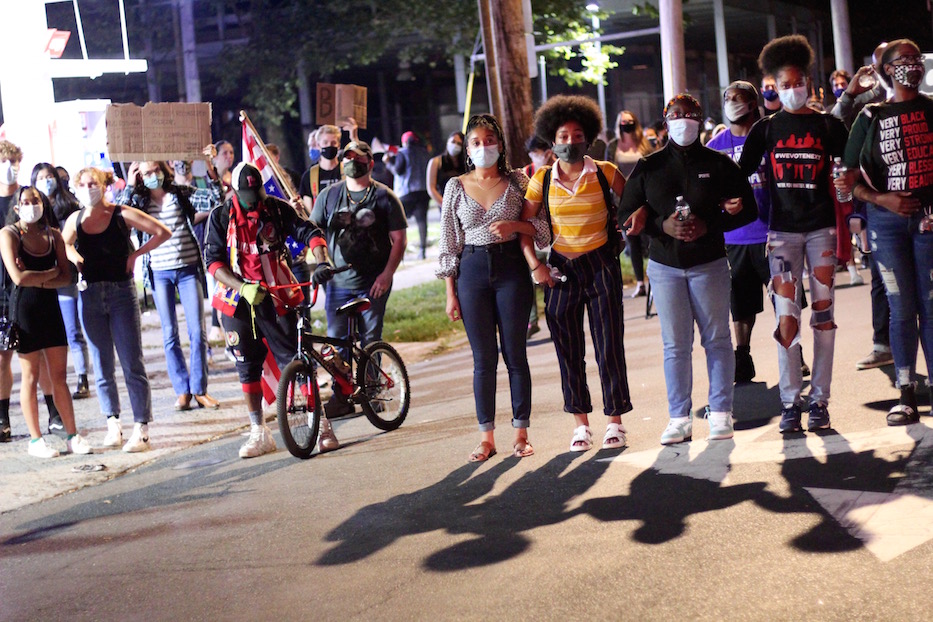
Lucy Gellman Photos.
Over 20 Black women danced in the middle of the street, lifting up the same three words like a mantra. At first, just a few ventured out to the intersection, where Whalley meets Sherman Avenue. Then it was dozens. Soon hundreds of people sat around them, a human firewall. Cars and buses honked and flashed their headlights, but didn't budge.
“Black women matter!” a chorus of voices sang out. Hands clapped in time. Marchers took a moment to flex their hips, stretch their arms, and flow to the words.
Hundreds of people took to the streets Thursday night to demand justice for 26-year-old Breonna Taylor, who was murdered by members of the Louisville Police Department in March in her own home. On Wednesday, a grand jury ruled not to charge the two officers who shot and killed Taylor. A third officer was charged with reckless endangerment for firing into a neighbor’s apartment. All three officers were armed with state-sanctioned murder weapons.
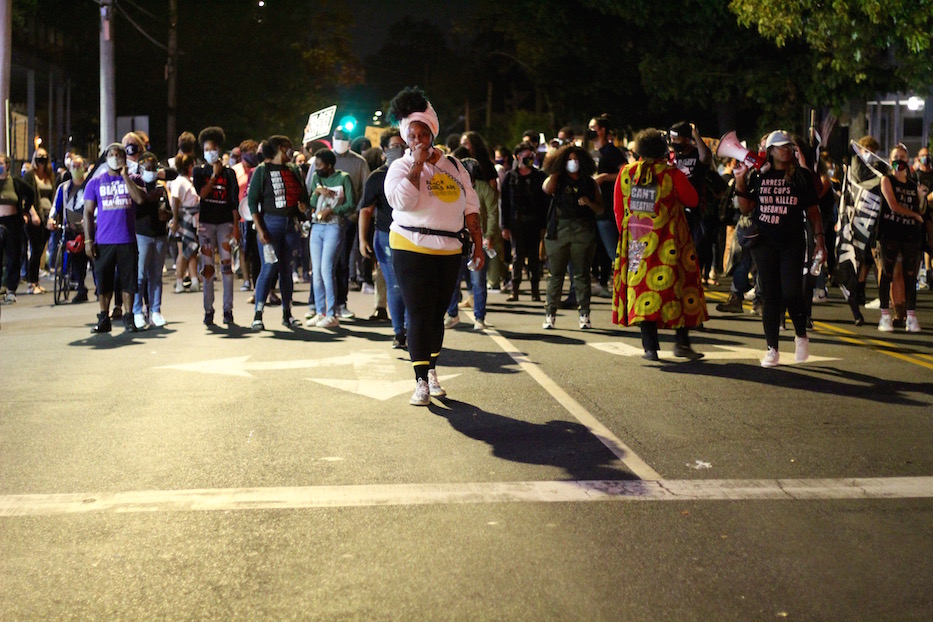
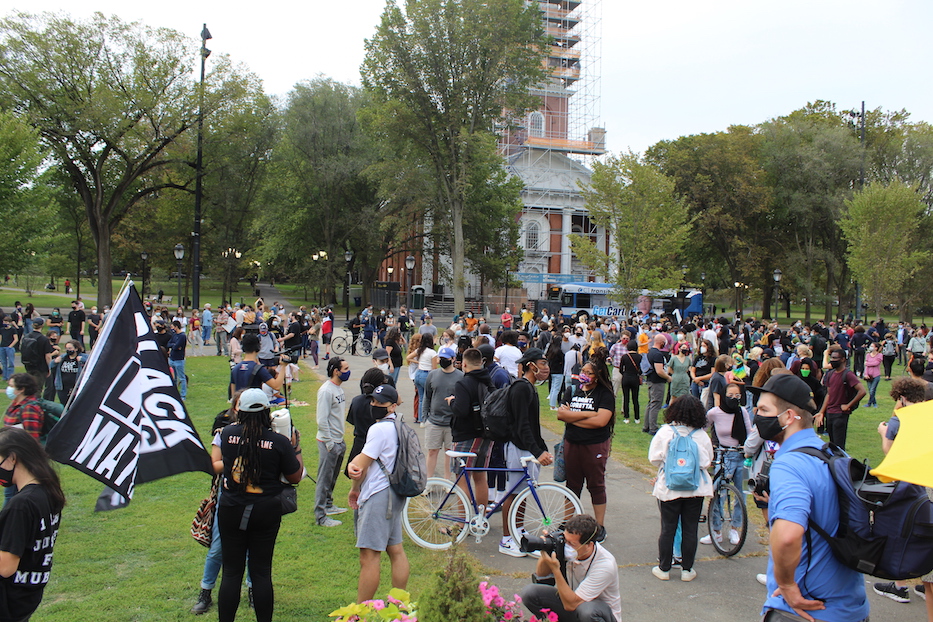
| Top: Sun Queen with protesters. Lucy Gellman Photo. Bottom: The beginning of the protest. Arturo Pineda Photo. |
Thursday’s action began at the New Haven Green and wove up Chapel Street, down Sherman Avenue, and onto Whalley Avenue and Broadway in a loop that skipped New Haven Police Department headquarters entirely. Once they were in motion, protesters walked against the flow of traffic, motioning to cars to turn around and go the other direction.
“We cannot continue to move forward like this shit is not happening,” said Ala Ochumare, a co-founder of Black Lives Matter New Haven and one of the organizers of the action. “We have to heal. We have to do our work. We’re not in a rush. We cannot continue to just keep moving like this is not happening. It is very inconvenient for Breonna’s family to be having to bury her. It is very inconvenient for each and every one of us to be here, because we’re risking our lives.”
The rally began at the New Haven Green a little after 5 p.m., with poetry, prayer and personal storytelling that anchored the event. Rev. Jack Davidson, who is the pastor at Spring Glen Church in Hamden, encouraged attendees to turn their anger—and their protest—into collective action.
He urged them to take what they might be feeling, and channel it into changing the system. Beside him, Citywide Youth Coalition Director Addys Castillo burned white sage to cleanse the space.
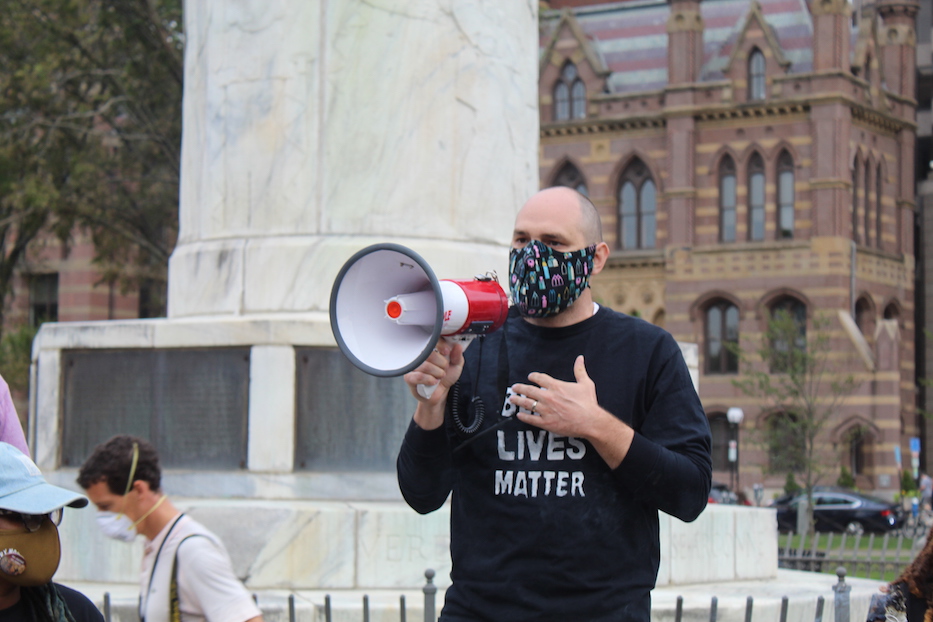
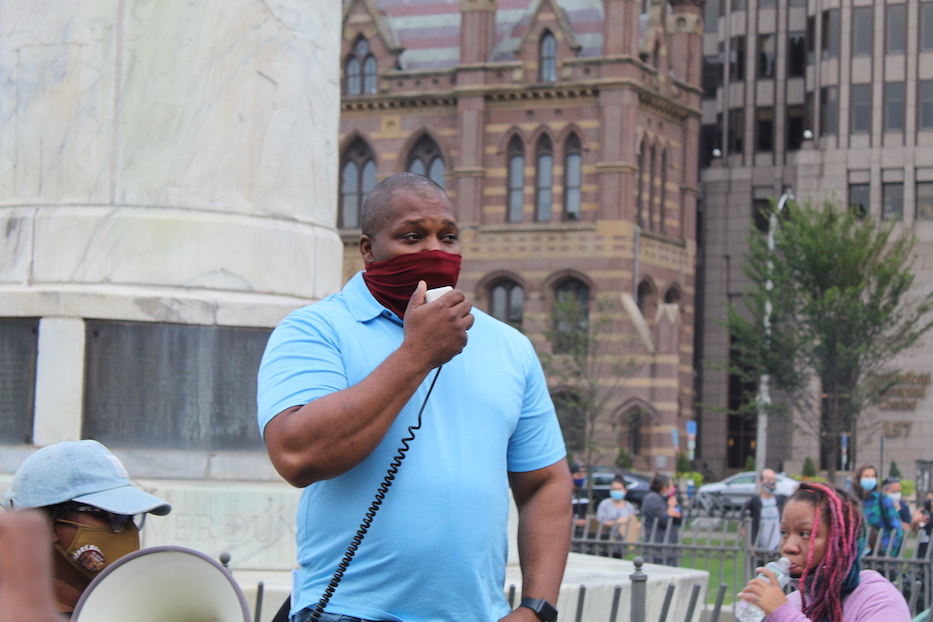
| Top: Pastor Jack Davidson. Bottom: State Sen. Gary Winfield. Arturo Pineda Photos. |
"Whatever faith background you come from, I want to assure you that rage is a righteous and sacred emotion,” he said. “I am not here to ease your anger, but to encourage you to channel it towards justice. To let you use it for strength and courage. To remind you that Black Lives Matter. To remind you that Breonna Taylor's life mattered."
A rallying cry is a prayer, he said. Every time a victim’s name rings out, that is a prayer too. He led the crowd in chanting, “Say her name! Breonna Taylor!”
Davidson’s gospel of action turned into one of public policy. State Sen. Gary Winfield spoke about his experience as a Black legislator working on police accountability in the state, while also being the target of racial profiling. Winfield was a driving force behind the passage of House Bill 6004: An Act Concerning Police Accountability in July.
“If the person responsible for writing the laws, for making sure that there is accountability, if someone has power over me, what happens to everyone else?” he asked aloud.
He also called out Kentucky Attorney General Daniel Cameron for his comments on Taylor's case. When Cameron announced the grand jury’s decision, he maintained that her death was not a murder. He called the two officers who shot her justified in using deadly force.
“How a man [Cameron] can use his Blackness to tell us ’well I am a Black man and I understand’ when clearly he doesn't understand what we’re talking about,” Winfield said.
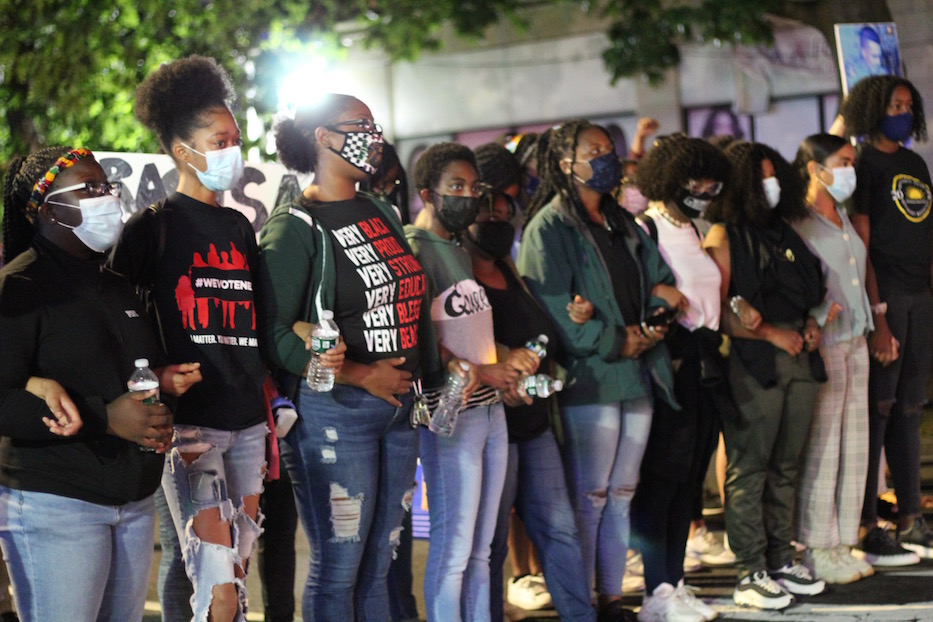
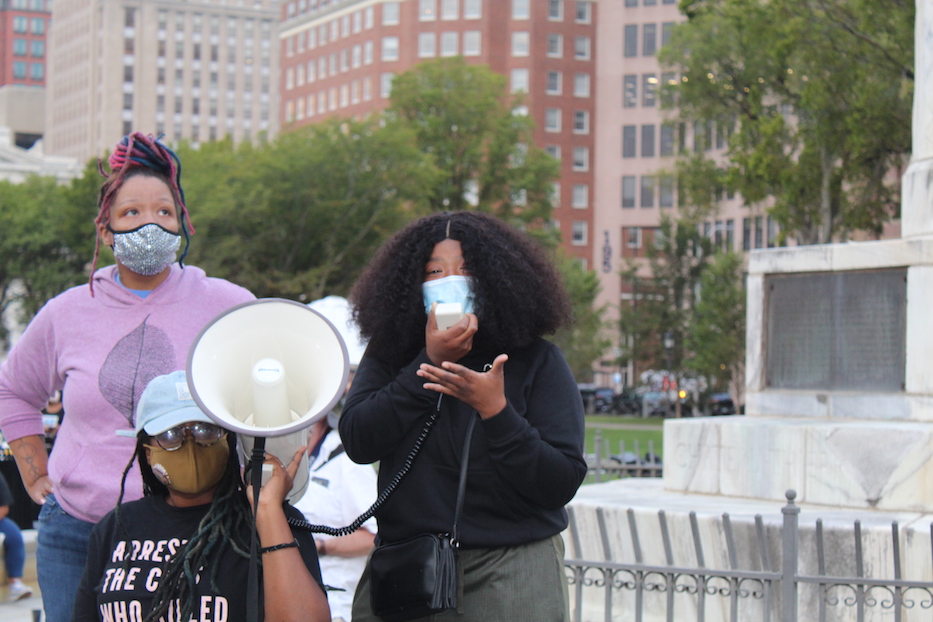
| Top: Protesters at Whalley and Sherman. Lucy Gellman Photo. Bottom: Jaeana Bethea. Arturo Pineda Photo. |
Jaeana Bethea, a student at Amistad Academy, recounted the pain of attending virtual classes during which no one acknowledged the ruling or Taylor's death. In one case, a teacher gave her five minutes of class time to discuss the ruling Wednesday. Five minutes to talk about a miscarriage of justice felt like a miscarriage of justice.
“I shouldn’t have to beg my teacher to talk about it,” she said. “It should not be an inconvenience to talk about someone that lost their life. We shouldn’t pretend that it is normal, when it’s not.”
After a land acknowledgement from Norman Clement—New Haven stands on Quinnipiac territory—over 400 people took to the streets marching up Chapel Street, chanting “No justice, no peace!/No racist police!”
The crowd grew quickly, as bystanders on the sidewalk or in their cars joined the movement. It stopped at Chapel and Park, a knot of bodies next to Barracuda and Pad Thai. Some of the onlookers raised their fists in support, others left to their cars.
Ochumare noted that it was not business as usual—and shouldn’t feel like it for any of the drivers or the attendees.
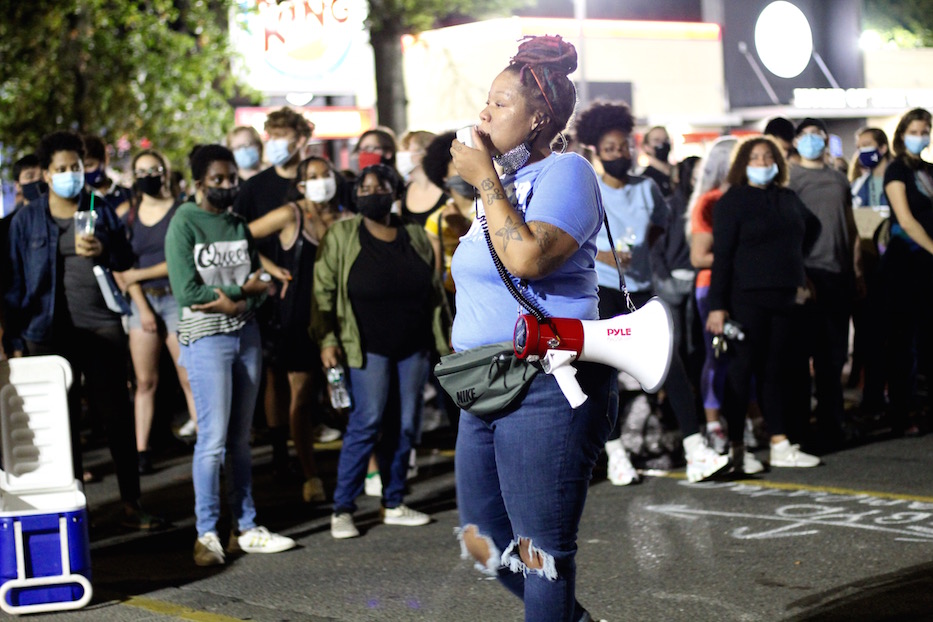
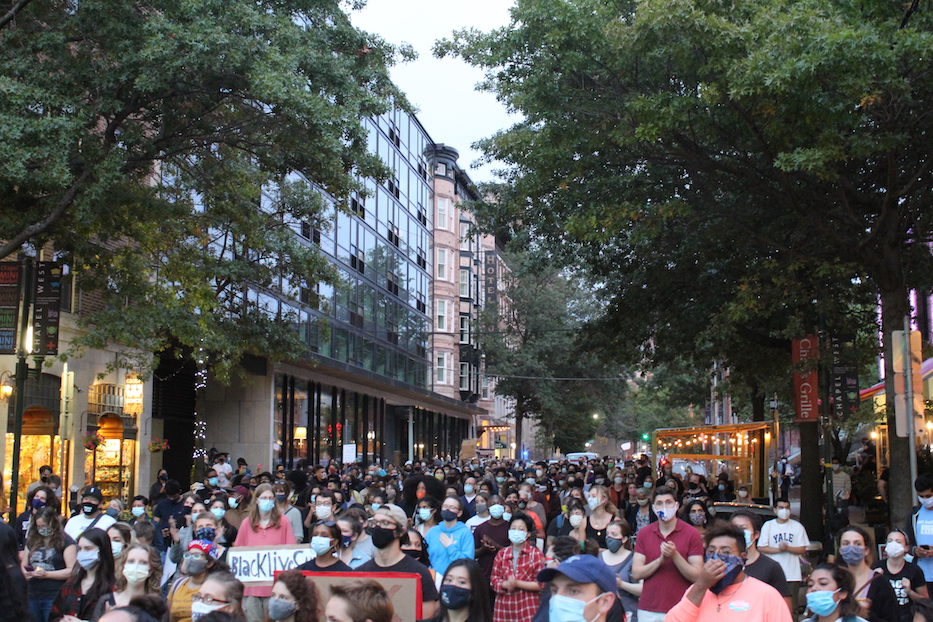
| Top: Ala Ochumare. Lucy Gellman Photo. Bottom: Chapel Street filled with protesters. Aturo Pineda Photo. |
“Those of us who are Black and Brown and queer and differently abled, it's just another risk on our lives,” she said. “Every day. So thank you for risking your lives with us. Thank you for being touched by someone hundreds of miles away from you. Thank you. And we gonna take this time."
She invited people in their cars to join the movement or figure out a way to turn around. At Chapel and Dwight, a woman hopped out of her car and jumped in, after learning what the protest was about. To encourage bystanders to join, Ochumare burst into song.
Breonna Taylor was a Freedom Fighter and she taught us how to fight!
We’re gonna fight all day and night until we get it right!
Which side are you on my people, which side are you on?”
“We on the freedom side!” protesters responded.
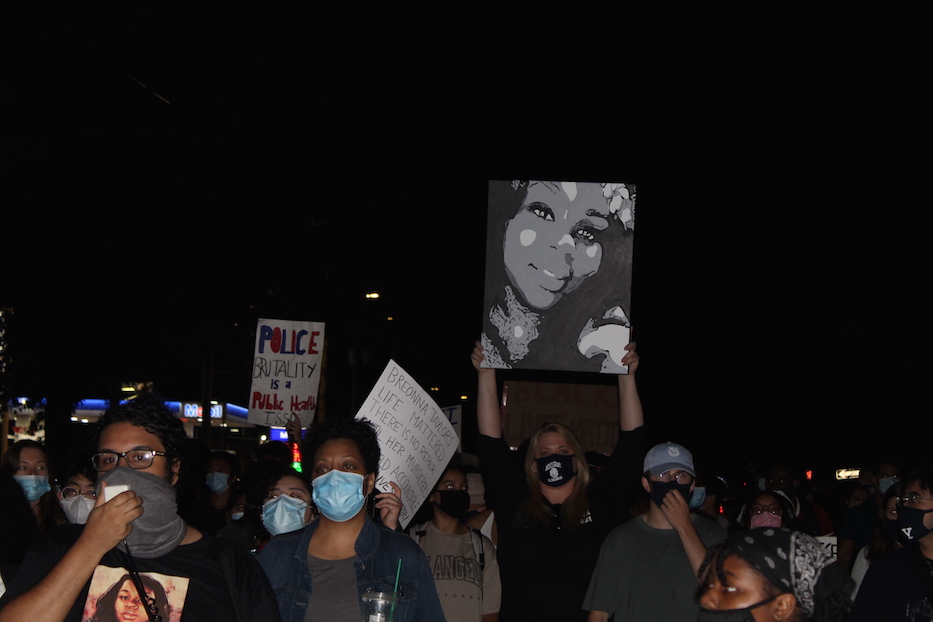
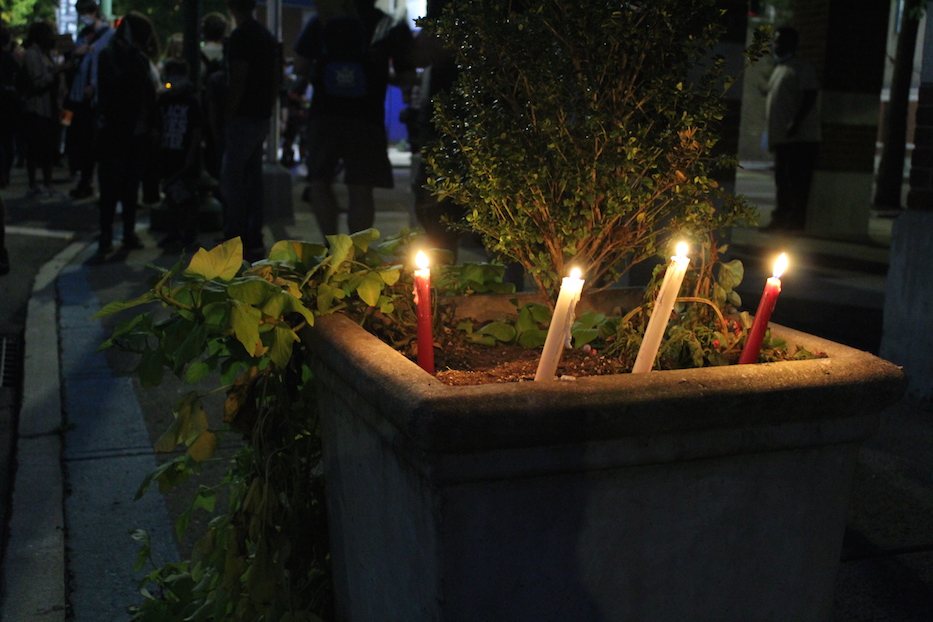
| Aturo Pineda Photos. |
By the time the group reached Sherman Avenue, the march had become propulsive. At organizers’ direction, white people stood at intersections as marchers of color took their time in the middle of the street. In the blue, gritty light of nightfall, the corner of Chapel and Sherman was alive.
People came out onto their porches, waving and raising their fists. Two young boys from the neighborhood joined on their bikes, trailing the group as it stopped and started in an effort to wait for stragglers.
“Ain’t no power/Like the power of the people/’Cause the power of the people don’t stop!” the crowd cried. “Fist up!/Fight back!/Divest!/Reinvest!”
Drivers, suddenly turning around in the street, whipped out their smartphones and began to record while they were stuck in traffic. At Sherman and Elm, a construction worker waved the group on, helping hundreds of people cross the street.
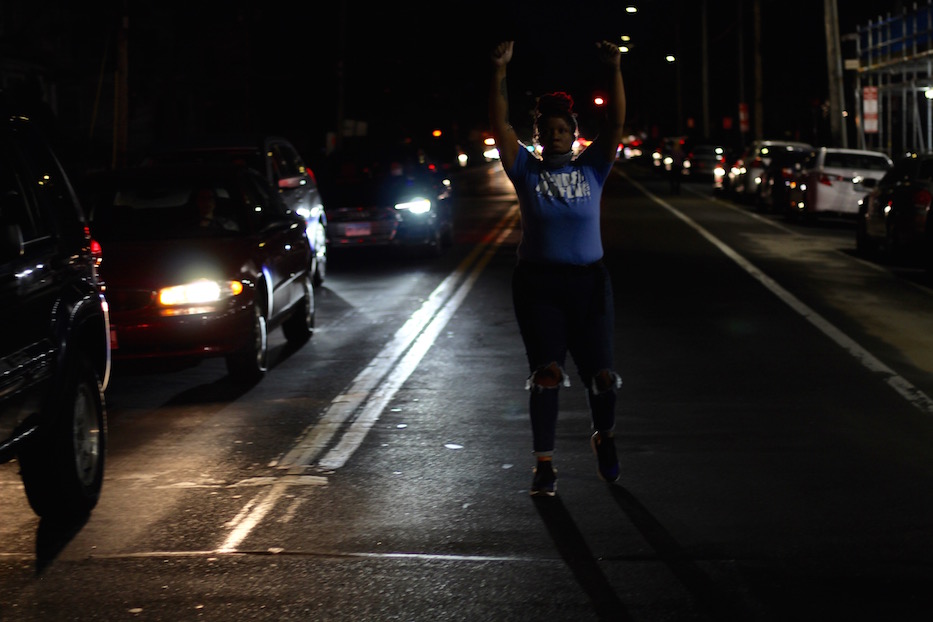
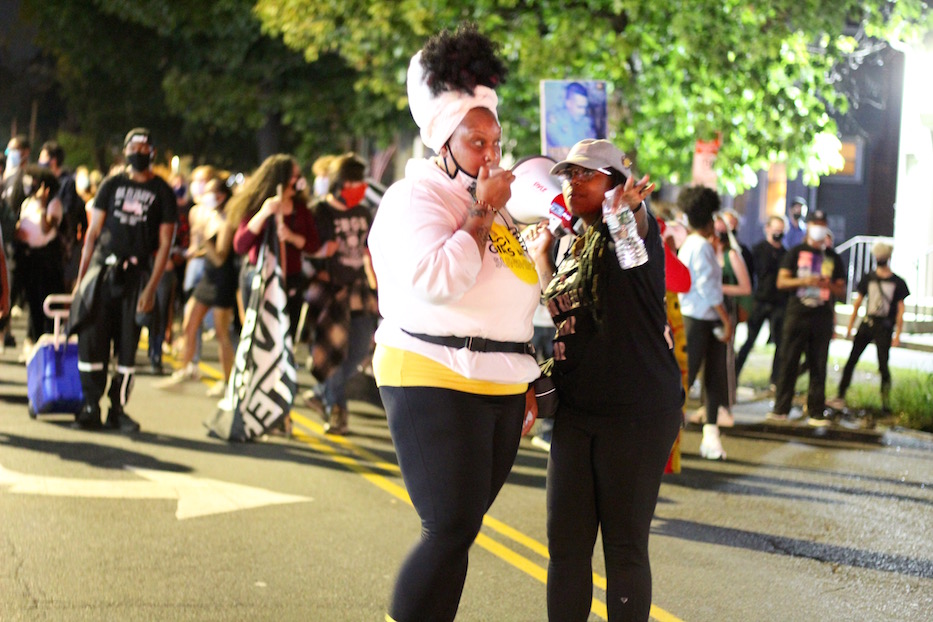
Lucy Gellman Photos.
Within minutes, marchers were standing in front of Whalley Avenue. To their left, a beauty supply store sat quiet, lights off for the night. To their left, a gas harsh yellow lights blazed at a gas station. The intersection rumbled with traffic. Sun Queen lifted the megaphone, calling for a front line.
“Black women matter!” attendees yelled. “Black girls matter!” “Black joy matters!” “Black kings matter!” “Black queens matter!”
From somewhere close to the front of the group, the sound of a human beat box purred to life. John Garusha, a music teacher at Amistad High School, stood with a speaker on one shoulder and a mic to his mouth. Every few minutes, he summoned a catalogue of sounds right from in his throat.
Close by, Amelia Sherwood mourned not only the loss of Taylor, but the grief that her boyfriend is feeling in the wake of her death. Kenneth Walker was with Taylor the night that she was murdered. The two had gone out for dinner. She made cookies before bed. The two fell asleep watching Netflix.
They woke up when they heard people trying to get into the apartment. Walker didn’t know they were officers because, according to him and to several neighbors, they never introduced themselves. He fired a single shot from a legal, permitted firearm in self-defense. He was later criminally charged.
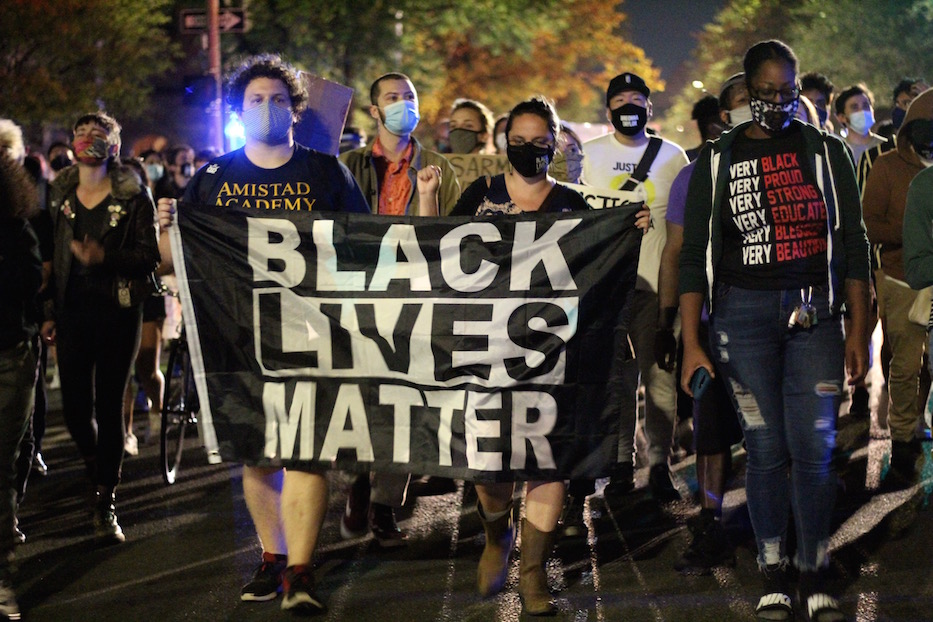
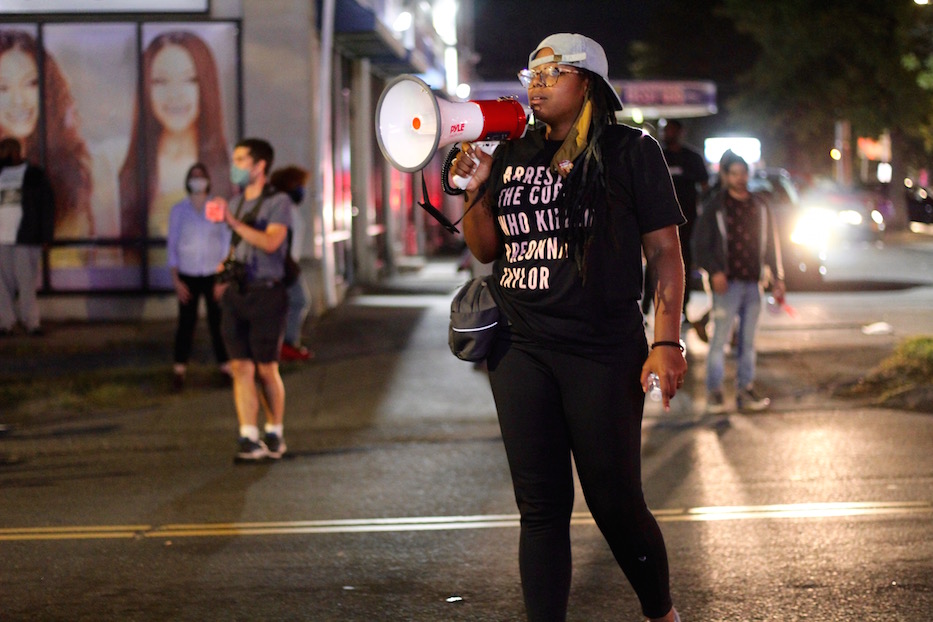
“He protected her,”Sherwood said. “He protected her. He did exactly what he was supposed to do. He protected her. He protected her. He was protecting his house. He was protecting his woman. When you are under attack, what do you do?”
“Stand up fight back!” protesters yelled back.
“Black women matter!” the crowd sang. As if on cue, a fleet of white protesters flooded the street to stop traffic. Black woman walked into the center of the intersection and linked arms. As if in slow motion, a few began to dance. Soon dozens of feet were stomping, hands clapping.
“Black women matter!” Someone joked that the stalled, chronically late 243 bus could idle by the curb a little longer. A few cars started to honk along with the chant’s staccato rhythm.
“Black women matter!” bodies swayed to the words. Garusha added a beat that came right from his chest. Across the intersection, a light blinked from red back to green. The cars remained still, laying on the horn every few minutes. Jeremy Cajigas took the megaphone.
They lock us up and shoot us down, they wailed as it became a call-and-response. There’s no justice in this town.
A line of protesters, all Black women, held each other by the shoulders and swayed in time with the music.
Mama, mama can’t you see? What the system’s done to me.
Back in the center, Robin Ellington stepped forward. She pulled down her mask to denounce the $12 million settlement that the City of Louisville has offered Taylor’s family after its officers killed Taylor in her own home.
“I know it wouldn’t be good enough for me if they shot down my child” she said. Whalley Avenue cast a red-and-white industrial glow around her. “Twelve million, 50 million, 100 million—those settlements are going to stop coming eventually. And then they’re going to be still killing. Still killing. Still killing, instead of murdering."
"Twelve million is not good enough when you take my family member and cut them down. No, it’s not good enough. And it should never be good enough! What do we want?”
“Justice!” protesters cried back.

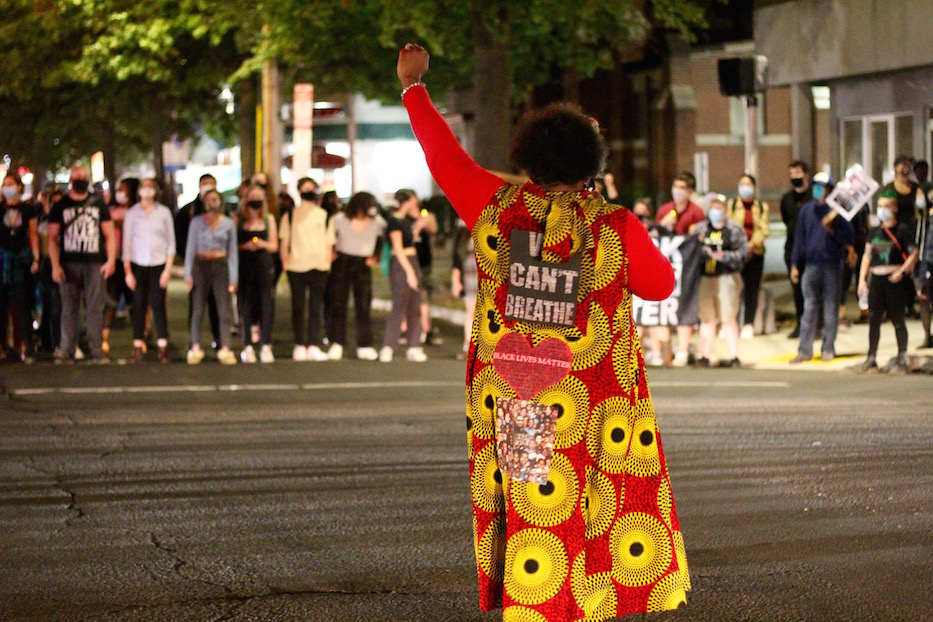
| Top: Protesters on Whalley. Bottom: Marcey Lynn Jones. Lucy Gellman Photos. |
Cars stood still with the occasional honk. An ice cream truck parked on one side of Sherman, prompting calls to give free ice cream to Black women (the owner of the truck did not heed them; he did sell ice cream to a few protesters). As the group moved again, Ochumare urged protesters to think of the march as church-like, but in the era of COVID-19.
She exhorted hand sanitizer breaks and social distancing. She joked that she’s not a fan of wearing her mask, but she does it to keep those around her safe.
While they waited, she launched into “I Love Being Black,” written by members of the Black Youth Project in 2018. Cajigas segued into the Peace Poets’“I Can’t Breathe,” teaching it before they snapped back into motion. The song was inspired by Eric Garner’s last words before he was murdered by Officer Daniel Pantaleo in Staten Island in 2014.
I can hear my brother crying I can't breathe,
Now I'm in a struggle singing I can't leave.
Calling out the violence of these racist police.
We ain't gonna stop till our people are free.
Every section of lower Whalley—zoned for industrial use, and usually buzzing with cars going well over the speed limit—seemed transformed by their loud, certain presence. At Stop and Shop, drivers slowed down to see what was going on as the nearby auto body shop cast a dim red light.
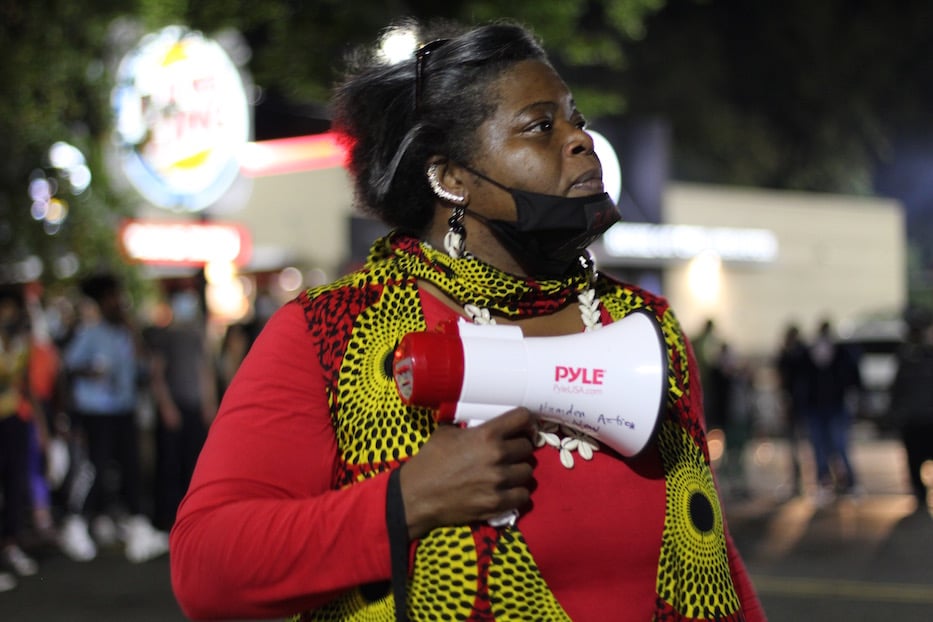
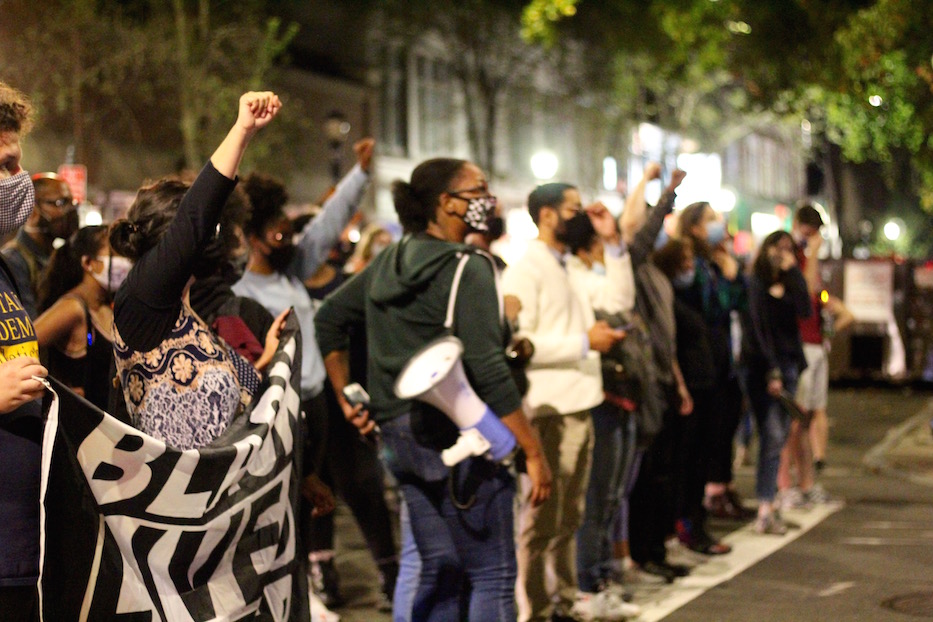
| Top: Marcey Lynn Jones on Whalley. Bottom: Protesters on Elm Street later in the march. |
Outside El Amigo Felix, a handful of outdoor diners pressed up to the fence. Some clapped and joined in chanting; others recorded as marchers strode past. The group stopped and sat as at the intersection of York and Broadway. Two full lanes of traffic began to honk from one side of the street.
The junction has become a meaningful one for protests: it was the site of a massive march that followed the officer-involved shooting of Stephanie Washington and Paul Witherspoon last year in April. Now, it feels a little like a designated pilgrimage spot.
As the crowd sat on the ground, Ochumare shifted the focus to the census and upcoming elections. With the Sept. 30 census deadline quickly approaching she emphasized the importance of Black and Brown communities being counted. She spoke on the importance of both voting and running for municipal office.

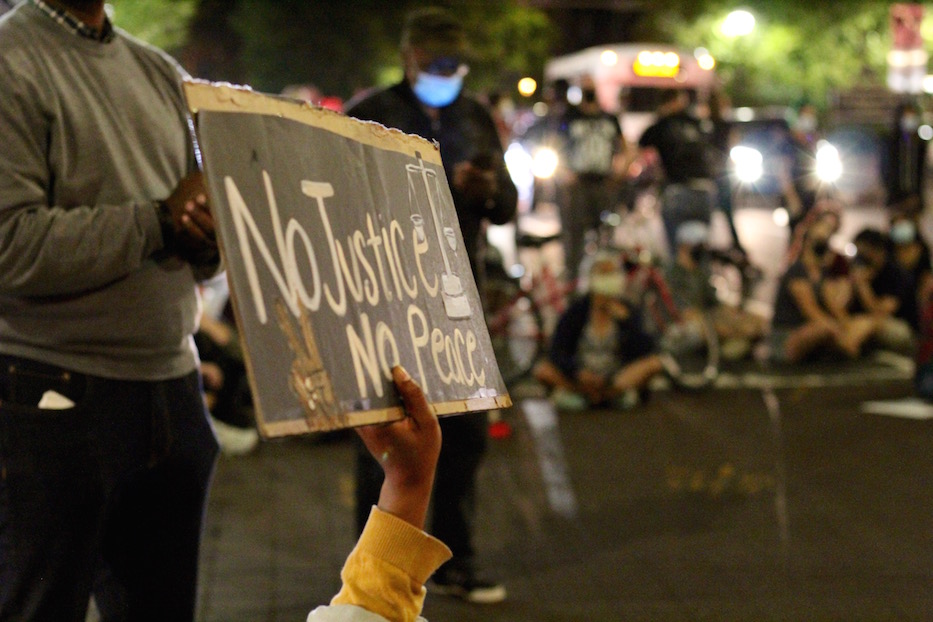
Lucy Gellman Photos.
“Young people, I’m talking to the 18-year-olds,19-year-olds, y’all are the folks that we want to put into automatic seats,” she said. “Y’all are the most affected by this oppression in the city of New Haven. That’s why y’all are gonna be the people to help make this change.”
She encouraged marchers to learn about the Board of Alders and Board of Education, and then run for and fill seats on both. She cited Justin Farmer’s campaign as a prime example, noting that he ultimately lost "to white supremacy," and a narrow margin of a few thousand voters. She begged parents among the protesters to teach tolerance to their children, so that hers may experience a safer world.
“We need to run 15 people at the same time,” she said. “Because Republicans and Democrats aren’t doing shit for us no more. They have never done anything for us actually.”
The crowd returned to the Green to pay respects to Breonna Taylor once more. In the dark of the night, Sun Queen sang Taylor’s name over and over, punctuated with the phrase “we love you/Breonna.” Marcey Lynn Jones stood in front of the dimly lit altar offering libations to Taylor and all the ancestors before her.
After a moment of silence, she asked members of the group to call out the names of their own ancestors, those who had passed away. The crowd responded with dozens of names: “Charlie, Rumi, Anna, Jordan, Gloria.” Some went up as throaty cries in the night. Other protesters seemed as if they were trying something new.
“We call the ancestors for strength when we have run out,” she said.
In the end, she offered the reflection on refusing to accept the reality at hand but acknowledging all of the complex emotions that come with grieving and liberation.
“Every time you feel like shedding a tear, shed it,” she said. “But we cannot let it be alright.”

